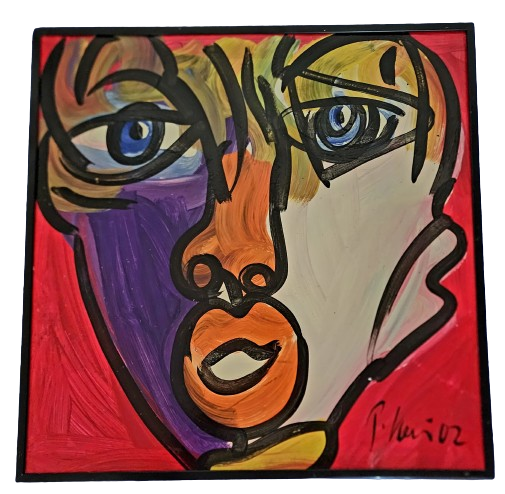
Germany

Peter Keil Warhol 02 Red Purple Original Oil Painting by Peter Keil
Warhol 02 Red Purple Original Oil Painting by Peter Keil One of a Kind Artwork on Masonite Panel by The Wild Man of Berlin, a Famous Contemporary Artist. 2002 Signed by Peter Keil & Dated Oil Painting on Masonite Panel Original Artwork Size 24x24. All of Peter Keil's Art Used Thick Paint & Some Paint Flaking May Be Present Due to the Age and Nature of His Work. Painting of Andy Warhol Friend Face Pruple Red & White. Intense Expressionism in Peter Keil's Warhol 02 Red Purple The "Warhol 02 Red Purple Original Oil Painting" by Peter Keil, also known as The Wild Man of Berlin, is a captivating exploration of form and color through the lens of Neo-Expressionism. This one-of-a-kind artwork on a Masonite panel embodies the spirited energy of the artist, a famous contemporary figure known for his daring use of colors and profound representation of faces. The 2002 piece, signed and stamped with the year by Keil, is a square of emotion measuring 24x24 inches, where the thick application of paint forms an image of Andy Warhol, revealing the profound influence of pop art on Keil's work. Keil's artistic method is defined by a bold, impasto technique where the paint is layered on thickly, giving the artwork a three-dimensional texture that is both seen and felt. This technique results in some degree of flaking over time, which is considered an inherent characteristic of Keil's work, adding to its authenticity and historical value. The "Warhol 02 Red Purple" painting is a testament to this style, with its vibrant reds and deep purples merging to form the iconic visage of Warhol, set against a stark white background. Peter Keil's Contribution to Contemporary Art Peter Keil's contribution to street pop art and graffiti artwork is substantial, as he brings street art's raw, untamed essence into the gallery. His work eschews the conventional polish and restraint often associated with fine art, instead embracing a wild abandon more commonly found on the streets and in the alleys where graffiti thrives. The "Warhol 02 Red Purple" vividly illustrates this philosophy, with the painting's subject – a pop art pioneer – being depicted in Keil's uninhibited style, creating a bridge between the two artistic worlds. Each of Keil's paintings is an original narrative, a story told in the visual language of colors and shapes. Collectors and enthusiasts of Keil's work are attracted to his paintings' intense emotion and distinctive style. In the case of "Warhol 02 Red Purple," the allure is enhanced by the subject matter – the legendary Andy Warhol – which positions the painting at the intersection of pop art heritage and contemporary artistic innovation. Owning a piece by Peter Keil is more than an acquisition of art; it is an immersion into the vibrant life story of the painting itself. The flaking paint, the bold strokes, and the striking contrasts create an experience that is as evocative and complex as the artist himself. The "Warhol 02 Red Purple" is a vibrant symbol of Keil's enduring artistic vision and impact on the art world. The "Warhol 02 Red Purple Original Oil Painting" by Peter Keil is a visual feast and an essential piece of contemporary art history. This work encapsulates the essence of street pop art and graffiti through the lens of a master painter whose unorthodox approach to art has captured the attention of the global art community. Keil's painting celebrates expressive freedom and the power of art to convey profound human emotion and thought.
$587.99


